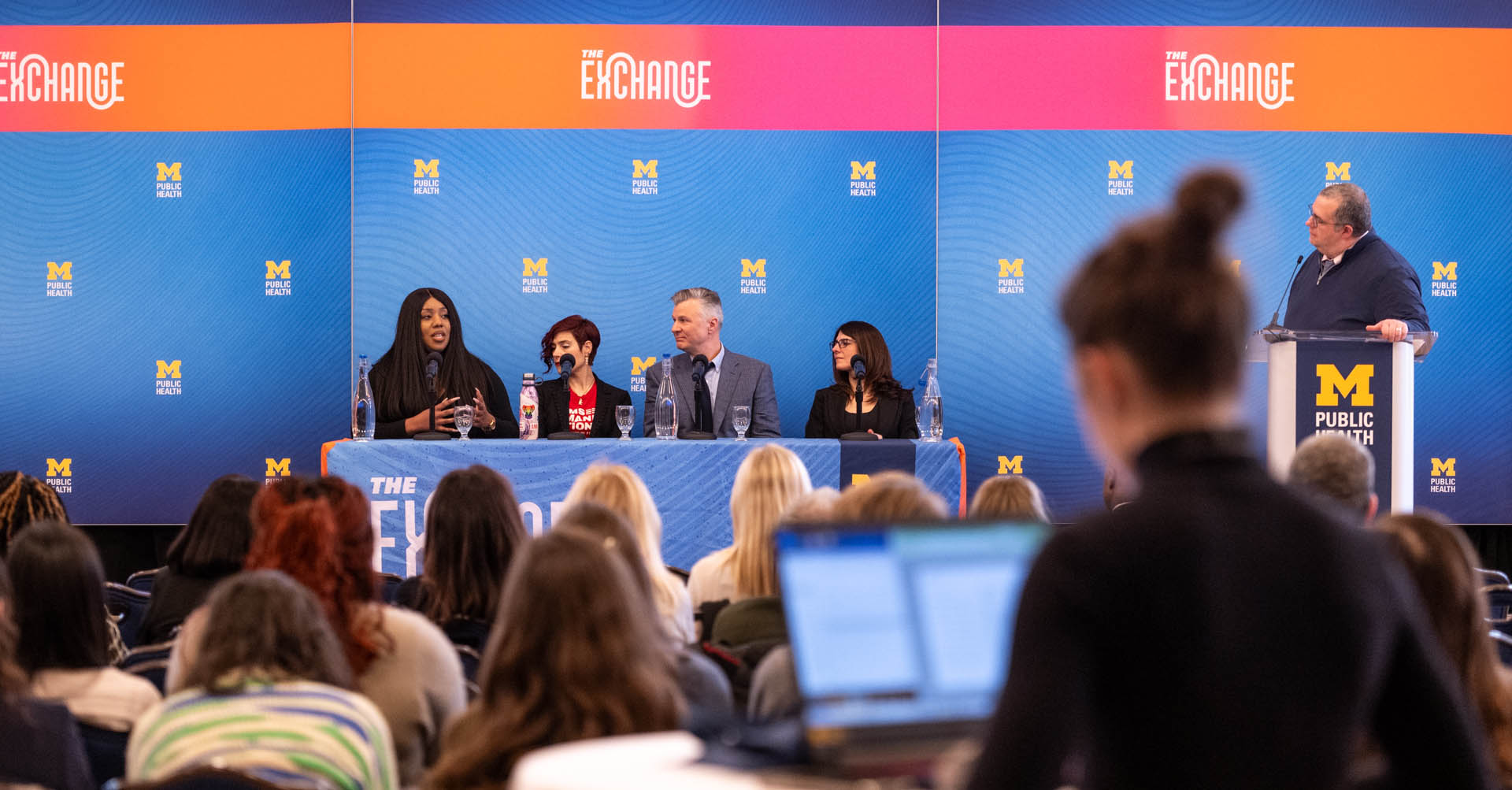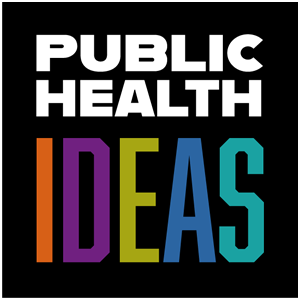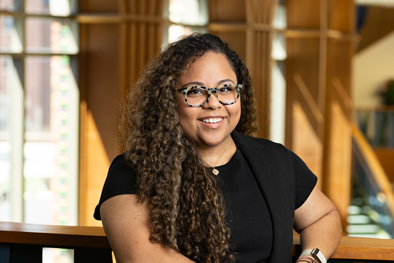5 Takeaways from The Exchange: Public Health approaches to ending gun violence

The pervasiveness of gun violence in American life is a public health issue that needs to be addressed. More than 326 people are killed or injured by a firearm every day and there are 39,000 premature deaths annually. Firearm injuries are now the leading cause of death for children and teens.
The University of Michigan School of Public Health is committed to finding lasting solutions to this public health crisis and to creating a space for critical conversations to enable researchers and community members to advocate for change and develop evidence-based solutions that will save lives. For example, the school recently launched Public Health IDEAS: Interdisciplinary Discovery, Engagement + Actions for Society as a way to convene expertise to rise to the challenge of addressing pressing public health issues like gun violence.
On Tuesday, February 13, 2024, Michigan Public Health brought together academic experts and community members in a day-long event to explore the public health approaches to ending gun violence. The event was planned in collaboration with the Institute for Firearm Injury Prevention at the University of Michigan. Read a full recap of the event on the Michigan Public Health News Center.
There were a handful of themes and ideas that felt very present throughout the day’s keynote and panel discussions. Here are five takeaways:
1. Including a variety of perspectives is necessary to build solutions
Addressing gun violence is multi-faceted. The causes are complex, involving factors across the ecological spectrum from individual behavior to policy-related issues and more. As such, various disciplines and perspectives are needed at the table to look at the issue from a variety of different angles.
Seeking solutions requires the involvement of researchers, gun owners, communities, medical professionals, policymakers, advocacy groups, and the arts, among others. Of particular importance are survivors of gun violence.
“The people closest to the problem are often the closest to the solution,” said Rebeccah Sokol, assistant professor at the University of Michigan School of Social Work and co-director of the training and education core at the Institute for Firearm Injury Prevention. “But way too often they are the furthest away from the power to do anything about it.”
By inviting everyone to have a seat at the table, identifying gaps and developing common threads for action will become much clearer.
2. Proper implementation and enforcement of firearm laws is critical
During the panel discussion “The Legislation Tightrope: Policy Solutions to Gun Violence,” April Zeoli, professor of Health Management and Policy at Michigan Public Health, said: “Laws are just words on a paper unless they are implemented properly.”
The implementation and enforcement of firearm laws is critical in assessing if the laws are working to decrease firearm injuries and deaths. There needs to be appropriate communication for constituents and agencies involved. People need to know about the laws and the process in order for them to use it.
Additionally, states that have yet to enact policies such as extreme risk protection orders (also called red flag laws), which were recently enacted in Michigan, will look to data from other areas across the country as evidence to support (or deny) the proposal of such interventions. Proper implementation and enforcement are critical to ensure these proven policies are rolled out more widely.
Public Health IDEAS for Preventing Firearm Injuries
 Michigan Public Health is uniquely positioned at the epicenter of research, resources,
and expertise to rise to the challenge and address some of the world’s most pressing
problems. That is why we launched Public Health IDEAS—which represents Interdisciplinary Discovery, Engagement + Actions for Society—to
increase collaboration and advance research and engagement in key areas of public
health to achieve meaningful, lasting impact.
Michigan Public Health is uniquely positioned at the epicenter of research, resources,
and expertise to rise to the challenge and address some of the world’s most pressing
problems. That is why we launched Public Health IDEAS—which represents Interdisciplinary Discovery, Engagement + Actions for Society—to
increase collaboration and advance research and engagement in key areas of public
health to achieve meaningful, lasting impact.Learn more about Public Health IDEAS for Preventing Firearm Injuries.
3. Academic-community partnerships continue to be important in driving research and action
The relationship between academia and the communities they serve is foundational. The event’s conversations, and in particular the panel “Build the Big Tent: Community Engagement Solutions to Gun Violence” illuminated how academic institutions such as the University of Michigan, can serve as a space where research and community experiences intersect.
Michigan Public Health has a long history of community-based participatory research and these community partnerships are creating a roadmap for interventions that are not just theoretical but steeped in the lived experiences of those most affected
by gun violence. By listening to, learning from, and co-creating directly with communities, academic institutions and communities can work together to build evidence-based solutions that are culturally attuned, actionable, and sustainable.
“I think that at times we talk so much about the problem that it can generate a sense of hopelessness,” said Charles Branas, chair of the Department of Epidemiology at Columbia University. “My hope is that we can turn that around and not simply talk about the problem being identified and documented, but what hopeful things—what bold solutions—can be co-created, co-initiated with communities that can generate long-term excitement about the possibility of a different future.”
4. As trusted messengers, anyone can make an impact
The power of personal influence cannot be overstated in the battle against gun violence. Each individual has the potential to be a catalyst for change, starting within their own networks and relationships.
In Brandon Wolf’s keynote address, the nationally recognized LGBTQ civil rights advocate, leader in the movement to end gun violence in America, and survivor of the 2016 shooting at Pulse Nightclub emphasized this idea and used his family as an example. While someone like his father—a gun owner—might not watch a particular television station or read a certain article that includes differing viewpoints than his own, he will take his son’s phone call. “We can have conversations that he would not have with absolutely anybody else. They don't come with judgment. Just a dad and a son talking about the world,” Wolf said.
Wolf called on those in the audience to become trusted messengers within their own networks as one way to harness their passion for solving this problem. Through these personal connections and conversations, as trusted messengers in our community, individuals can create ripples of impact through their conversations, shifting public opinion and bringing about lasting change.
5. Hope can fuel the change
The event highlighted an invigorating trend: More people than ever are eager to contribute to meaningful solutions to this public health crisis. Researchers during both panel discussions noted the increase in federal funding to study firearm violence and prevention. Even just a decade ago, funding opportunities for firearm research were slim. Community advocates highlighted growing interest from the public to be involved in their organizations. This surge of interest opens doors to new perspectives and fresh energy that can be harnessed for bold change and action.
“I believe that a world that we all can be proud of is not just possible; it’s inevitable.” Wolf said. “It’s inevitable because of the people in this room and the work you are doing—this is where the work happens. I think that the possibilities of the future are endless.”
About the Author
 Destiny Cook is the senior public relations specialist for the University of Michigan
School of Public Health. A communicator for globally recognized public health organizations
for the last eight years, she has a particular interest in educating scientists and
researchers on public engagement strategies to disseminate health information.
Destiny Cook is the senior public relations specialist for the University of Michigan
School of Public Health. A communicator for globally recognized public health organizations
for the last eight years, she has a particular interest in educating scientists and
researchers on public engagement strategies to disseminate health information.
- Learn more about Public Health IDEAS for Preventing Firearm Injuries
- Interested in public health? Learn more today.
- Support research and engaged learning at Michigan Public Health.
